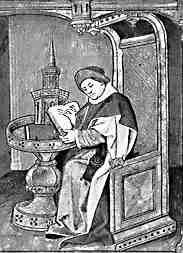
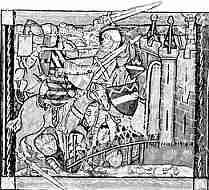
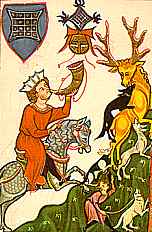
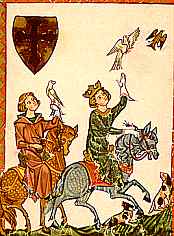
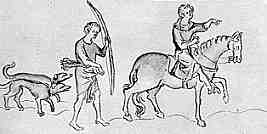
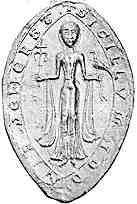
If you are looking at this page without frames, there is more information about medieval writing to be found by going to the home page (framed) or the site map (no frames).
| Works on Gentlemanly Pursuits | ||||||
| As high level literacy originated and was propagated in the medieval church, so textually complex works, and codices with high production values, were originally produced and read within the church by clerics literate in Latin. The aspirations of the laity to the ownership of high status goods caused the development of new forms of prestige literature. In the Carolingian era, nobles owned libraries of lavishly gilded books, but the nobility seem to have lapsed in literacy after this time, if they ever really had any. Around the 13th century, luxury editions of liturgical works such as psalters were produced for private patrons, for use their private chapels by their private chaplains and for display in their private libraries on their very fancy private library furniture. |  |
|||||
| Depiction of Guillaume de Lorris, author of the first part of the Roman de la Rose, reading in his fancy library furniture, in a manuscript of that work (Bodleian Library). (From Lanson 1923) | ||||||
| The wealthy and noble laity of around the 13th century onward required their own forms of literature, produced in suitably lavish volumes that served as symbols of status as well as repositories of knowledge and entertainment. The volumes of romance, derived from the songs and tales of the troubadours, the folk tales of Europe and the half remembered stories from the Latin Classics, were as beautifully written, illustrated and illuminated as any fancy psalter. The texts had layers of significance, weaving in fanciful reconstructions of the family history to enhance its status, and preaching certain moral values associated with the chivalric life. |  |
|||||
| A fight between armed and mounted knights on a castle drawbridge from a 14th century manuscript, Romance of the Holy Grail (British Library, add ms 10203). | ||||||
| See the section on Romance on this website for more detail on this subject. | ||||||
| The nobility of the later middle ages also required books in their vernacular languages about the aspects of their own lives that differentiated them from lesser folk. They had to know how to be noble. The books written for this purpose would appear to be about practical knowledge, but no literature of the middle ages is ever so simply classified. On the one hand, the subject matter of these books revolves around pursuits and activities that reflect high status. No doubt they all had servants and underlings who knew many of the necessary practicalities without need for a literary reference, but the books themselves were status objects and they reflected high status pursuits. On the other hand, authors of the middle ages were prone to use any subject under the sun as a vehicle for writing texts for moral improvement, and if anybody was in need of a bit of moral improving it was the increasingly wealthy and powerful upper classes of the late middle ages. | ||||||
 |
Hunting was an exclusively upper class preserve. The nobility owned the land and the beasts that lived on it, and it was their prerogative to hunt them. The imagery of hunting, whether stag hunting with dogs or hawking or falconing, is to be found in the illustrations of many medieval manuscripts of high status that are not actually devoted to the topic. The pictures may be representations of aristocratic book owners, authors or simply markers of social status. |  |
||||
| Two illustrations of aristocratic poets, employing hunting imagery, in the Manesse Handschrift, a 14th century volume of German lyric poetry. | ||||||
 |
One of a number of hunting scenes found in marginal drawings in a 14th century English psalter known as Queen Mary's Psalter (British Library, Royal 2 B vii, f.151). | |||||
| Aristocratic women also particpated in hunting pursuits, and the imagery of hunting was often employed on their personal seals to emphasise their high status. In the example at right, the lady holds her hunting bird of prey on her wrist, as well as a lily in her other hand to symbolise purity. |  |
|||||
| Seal of Idonia de Herste of c.1176-1180 (British Library, Campbell charter xxv, 20). (From Warner and Ellis 1903) | ||||||
| Manuals of hunting, and of the care of horses, dogs and birds of prey, were produced for aristocratic patrons in their vernacular languages. In France this was French, and in England it could be French, or the newly respectable English. While these works contained much practical information, they were not kept down in the stables, kennels or cages for reference on the job. Surviving volumes are beautifully written and illustrated works designed to occupy the library, along with the fancy psalters, books of hours and volumes of romance. Hunting was a high status pastime, and fancy hunting books were high status objects. If his lordship's master of horse or hounds had some useful but scruffy notes for his daily use, these have had a much reduced chance of survival over the centuries. His lordship's fancy books were, however, presumably read so that he had the knowledge to ensure that his servants were looking after his animals correctly. It was his aristocratic duty to ensure that things were done properly in this area. | ||||||
| Illuminating the Medieval Hunt is an exhibition from the Morgan Library of a very lavish production of the late 14th century Livre de la Chasse by Gaston Phoebus, Count of Foix, from their collections. There are 46 surviving manuscripts of this particular text. Medieval hunting manuscripts from East Anglia saved for the nation is a news item from the British Library, with some information on and illustrations from the Kerdeston Hawking Book and the Kerdeston Hunting Book, 15th century English manuscripts in East Anglian dialect spelling. The University of Glasgow Library has an exhibition Birds, Bees and Blooms: Natural History Books which includes images from a late 15th century French falconry manuscript which concentrates on the health and sicknesses of birds of prey. | ||||||
| These hunting books are therefore part of a larger genre of books which teach the aristocratic owner how to be a good manager of his estates. The fine books, like the hunting itself, are a privilege of wealth and status, but with that goes an obligation to be a good leader and manager of his domain. | ||||||
|
|
||||||
|
If you are looking at this page without frames, there is more information about medieval writing to be found by going to the home page (framed) or the site map (no frames). |
||||||